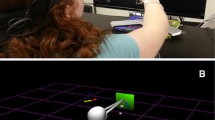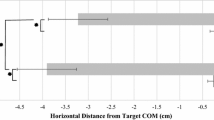Abstract
When grasping an object, our gaze marks key positions to which the fingertips are directed. In contrast, eye fixations during perceptual tasks are typically concentrated on an object’s centre of mass (COM). However, previous studies have typically required subjects to either grasp the object at predetermined sites or just look at computer-generated shapes “as a whole”. In the current study, we investigated gaze fixations during a reaching and grasping task to symmetrical objects and compared these fixations with those made during a perceptual size estimation task using real (Experiment 1) and computer-generated objects (Experiment 2). Our results demonstrated similar gaze patterns in both perception and action to real objects. Participants first fixated a location towards the top edge of the object, consistent with index finger location during grasping, followed by a subsequent fixation towards the object’s COM. In contrast, during the perceptual task to computer-generated objects, an opposite pattern in fixation locations was observed, where first fixations were closer to the COM, followed by a subsequent fixation towards the top edge. Even though differential fixation patterns were observed between studies, the area in which these fixations occurred, between the centre of the object and top edge, was the same in all tasks. These results demonstrate for the first time consistencies in fixation locations across both perception and action tasks, particularly when the same type of information (e.g. object size) is important for the completion of both tasks, with fixation locations increasing relative to the object’s COM with increases in block height.




Similar content being viewed by others
References
Abrams RA, Meyer DE, Kornblum S (1990) Eye-hand coordination: oculomotor control in rapid aimed limb movements. J Exp Psychol Hum Percept Perform 16(2):248–267
Bekkering H, Adam JJ, Kingma H, Huson A, Whiting HT (1994) Reaction time latencies of eye and hand movements in single- and dual-task conditions. Exp Brain Res 97(3):471–476
Biederman I, Mezzanotte RJ, Rabinowitz JC (1982) Scene perception: detecting and judging objects undergoing relational violations. Cogn Psychol 14(2):143–177
Bowers D, Heilman KM (1980) Pseudoneglect: effects of hemispace on a tactile line bisection task. Neuropsychologia 18(4–5):491–498
Brouwer AM, Franz VH, Gegenfurtner KR (2009) Differences in fixations between grasping and viewing objects. J Vision 9(1):1–24
de Grave DDJ, Hesse C, Brouwer AM, Franz VH (2008) Fixation locations when grasping partly occluded objects. J Vision 8(7):1–11
De Greef T, Lafeber H, van Oostendorp H, Lindenberg J (2009) Eye movement as indicators of mental workload to trigger adaptive automation. Lecture notes Comput Sci (LNCS) 5638:219–228
Desanghere L, Marotta JJ (2008) Eye movements and visuomotor behaviour: what are you looking at!?!. J Vision 8(6):299a
Deubel H, Schneider WX, Paprotta I (1998) Selective dorsal and ventral processing: evidence for a common attentional mechanism in reaching and perception. Vis Cogn 5:81–107
Dijkerman HC, McIntosh RD, Schindler I, Nijboer TCW, Milner AD (2009) Choosing between alternative wrist postures: action planning needs perception. Neuropsychologia 47(6):1476–1482
Efron R (1968) What is perception?. Humanities Press, New York
Hamed S, Duhamel JR, Bremmer F, Graf W (2002) Visual receptive field modulation in the lateral intraparietal area during attentive fixation and free gaze. Cereb Cortex 12(3):234–245
Hayhoe M, Ballard D (2005) Eye movements in natural behavior. Trends Cogn Sci 9(4):188–194
Hayhoe MM, Shrivastava A, Mruczek R, Pelz JB (2003) Visual memory and motor planning in a natural task. J Vision 3(1):49–63
He PY, Kowler E (1991) Saccadic localization of eccentric forms. J Opt Soc Am A 8(2):440–449
Helsen WF, Elliott D, Starkes JL, Ricker KL (2000) Coupling of eye, finger, elbow, and shoulder movements during manual aiming. J Mot Behav 32(3):241–248
Henderson J (2003) Human gaze control during real-world scene perception. Trends Cogn Sci 7(11):498–504
Jeannerod M (1988) The neural and behavioural organization of goal-directed movements. Clarendon, Oxford
Jewell G, McCourt ME (2000) Pseudoneglect: a review and meta-analysis of performance factors in line bisection tasks. Neuropsychologia 38(1):93–110
Johansson RS, Westling G, Backstrom A, Flanagan JR (2001) Eye-hand coordination in object manipulation. J Neurosci 21(17):6917–6932
Just MA, Carpenter PA (1976) Eye fixations and cognitive processes. Cogn Psychol 8:441–480
Kleinholdermann U, Brenner E, Franz VH, Smeets JB (2007) Grasping trapezoidal objects. Exp Brain Res 180(3):415–420
Kowler E, Blaser E (1995) The accuracy and precision of saccades to small and large targets. Vision Res 35(12):1741–1754
Land M, Hayhoe M (2001) In what ways do eye movements contribute to everyday activities? Vision Res 41(25–26):3559–3565
Land M, Mennie N, Rusted J (1999) The roles of vision and eye movements in the control of activities of daily living. Perception 28(11):1311–1328
Lederman SJ, Wing AM (2003) Perceptual judgement, grasp point selection and object symmetry. Exp Brain Res 152(2):156–165
Marotta JJ, McKeeff TJ, Behrmann M (2003) Hemispatial neglect: its effects on visual perception and visually guided grasping. Neuropsychologia 41(9):1262–1271
McCourt ME, Garlinghouse M (2000) Stimulus modulation of pseudoneglect: influence of line geometry. Neuropsychologia 38(4):520–524
McCourt ME, Mark VW, Radonovich KJ, Willison SK, Freeman P (1997) The effects of gender, menstrual phase and practice on the perceived location of the midsagittal plane. Neuropsychologia 35(7):17–24
McCourt ME, Freeman P, Tahmahkera-Stevens C, Chaussee M (2001) The influence of unimanual response on pseudoneglect magnitude. Brain Cogn 45(1):52–63
McGowan JW, Kowler E, Sharma A, Chubb C (1998) Saccadic localization of random dot targets. Vision Res 38(6):895–909
Melcher D, Kowler E (1999) Shapes, surfaces and saccades. Vision Res 39(17):2929–2946
Milner AD, Goodale MA (2006) The visual brain in action, 2nd edn. Oxford University Press, Oxford, England
Oldfield RC (1971) The assessment and analysis of handedness: the Edinburgh inventory. Neuropsychologia 9(1):97–113
Otto-de Haart EG, Carey DP, Milne AB (1999) More thoughts on perceiving and grasping the Müller-Lyer illusion. Neuropsychologia 37(13):1437–1444
Salvucci DD, Goldberg JH (2000) Identifying fixations and saccades in eye-tracking protocols. In: Proceedings of the eye tracking research and applications symposium. ACM Press, New York, pp 71–78
Thorpe S, Fize D, Marlot C (1996) Speed of processing in the human visual system. Nature 381(6582):520–522
Tucker M, Ellis R (1998) On the relations between seen objects and components of potential actions. J Exp Psychol Hum Percept Perform 24:830–846
Tucker M, Ellis R (2001) The potentiation of grasp types during visual object categorization. Vis Cogn 8:769–800
van Donkelaar P, Siu KC, Walterschied J (2004) Saccadic output is influenced by limb kinetics during eye-hand coordination. J Mot Behav 36(3):245–252
van Doorn H, van der Kamp J, Savelsbergh GJ (2007) Grasping the Müller-Lyer illusion: the contributions of vision for perception in action. Neuropsychologia 45(8):1939–1947
van Doorn H, van der Kamp J, de Wit M, Savelsbergh GJ (2009) Another look at the Nuller-Lyer illusion: different gaze patterns in vision for action and perception. Neuropsychologia 47(3):804–812
Van Orden KF, Limbert W, Makeig S, Jung TP (2001) Eye activity correlates of workload during a visuospatial memory task. Hum Factors 1:111–121
Vishwanath D, Kowler E (2003) Localization of shapes: eye movements and perception compared. Vision Res 43(15):1637–1653
Vishwanath D, Kowler E (2004) Saccadic localization in the presence of cues to three-dimensional shape. J Vision 4(6):445–458
Vishwanath D, Kowler E, Feldman J (2000) Saccadic localization of occluded targets. Vision Res 40(20):2797–2811
Werth R, Poppel E (1998) Compression and lateral shift of mental coordinate systems in a line bisection task. Neuropsychologia 8(26):741–745
Yarbus AL (1967) Eye movements and vision. Plenum Press, New York
Acknowledgments
This research was supported by a grant from the National Science and Engineering Research Council of Canada (NSERC) to J.J.M. and a studentship from the Manitoba Health Research Council (MHRC) to L.D.
Author information
Authors and Affiliations
Corresponding author
Rights and permissions
About this article
Cite this article
Desanghere, L., Marotta, J.J. “Graspability” of objects affects gaze patterns during perception and action tasks. Exp Brain Res 212, 177–187 (2011). https://doi.org/10.1007/s00221-011-2716-x
Received:
Accepted:
Published:
Issue Date:
DOI: https://doi.org/10.1007/s00221-011-2716-x




